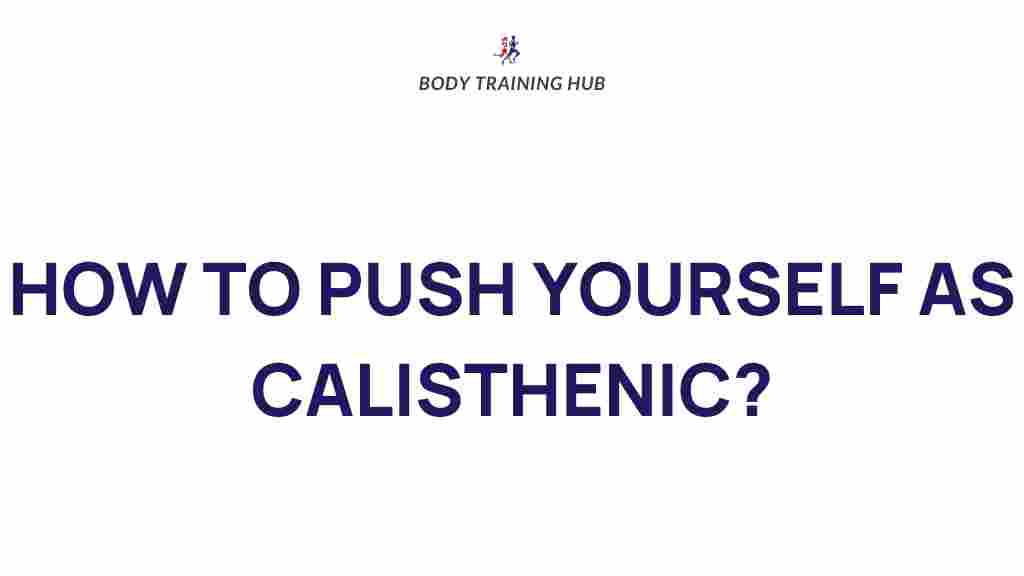Unleashing Your Full Potential in Calisthenics
Calisthenics is a form of bodyweight training that allows you to build strength, flexibility, and endurance without the need for weights or elaborate gym equipment. Whether you are a beginner or an advanced athlete, calisthenics can be a challenging yet rewarding way to achieve your fitness goals. In this article, we will explore essential tips and techniques to push yourself in your calisthenics journey, enabling you to unlock your full potential.
Understanding Calisthenics
Calisthenics involves using your own body weight as resistance to perform exercises. This form of training includes a variety of movements such as push-ups, pull-ups, squats, and planks. The beauty of calisthenics lies in its accessibility; you can work out almost anywhere, making it a perfect choice for those looking to enhance their fitness without a gym membership.
The Benefits of Calisthenics
- Improved Strength: Bodyweight training helps in building functional strength that translates well into everyday activities.
- Increased Flexibility: Many calisthenics movements promote flexibility and mobility.
- Enhanced Endurance: Regular practice can improve your stamina over time.
- Convenience: You can do calisthenics anywhere, anytime—no equipment required.
- Cost-Effective: It eliminates the need for expensive gym memberships or equipment.
Tips to Push Yourself in Calisthenics
1. Set Clear Goals
The first step to progress in calisthenics is to set clear, achievable goals. Whether you want to perform a certain number of push-ups, master a new skill like the muscle-up, or improve your overall strength, defining your objectives will keep you motivated. Here’s how to set your goals effectively:
- Specific: Clearly define what you want to achieve.
- Measurable: Choose metrics to gauge your progress.
- Achievable: Set realistic goals based on your current fitness level.
- Relevant: Ensure your goals align with your overall fitness aspirations.
- Time-Bound: Set a deadline to keep yourself accountable.
2. Create a Structured Workout Plan
To see progress in your calisthenics training, having a structured workout plan is essential. This plan should incorporate a mix of strength, endurance, and flexibility exercises. Here’s a sample weekly calisthenics workout plan:
- Day 1: Push exercises (e.g., push-ups, dips, and pike push-ups)
- Day 2: Pull exercises (e.g., pull-ups, chin-ups, and inverted rows)
- Day 3: Leg exercises (e.g., squats, lunges, and calf raises)
- Day 4: Core exercises (e.g., planks, leg raises, and hollow body holds)
- Day 5: Flexibility and mobility work (e.g., yoga or dynamic stretching)
- Day 6: Full-body workout incorporating all muscle groups
- Day 7: Rest and recovery
3. Incorporate Progressive Overload
To continually push yourself and achieve greater strength, it’s important to implement progressive overload. This means gradually increasing the difficulty of your workouts. Here are some techniques:
- Increase Repetitions: Gradually add more reps to your sets.
- Modify Exercises: Progress from basic to advanced variations (e.g., from knee push-ups to archer push-ups).
- Decrease Rest Time: Shorten the rest intervals between sets.
- Add Explosiveness: Incorporate explosive movements like clap push-ups or jump squats.
4. Focus on Form and Technique
Proper form is crucial in calisthenics. Not only does it prevent injuries, but it also ensures that you’re effectively targeting the right muscles. Here are tips to maintain good form:
- Engage Your Core: Keep your core tight during exercises to stabilize your body.
- Maintain a Full Range of Motion: Ensure you are moving through the full range of motion for each exercise.
- Control Your Movements: Avoid rushing through exercises—focus on slow, controlled movements.
5. Stay Consistent and Motivated
Consistency is key to achieving your fitness goals. Here are some strategies to help you stay motivated:
- Create a Workout Schedule: Set a specific time to work out each day.
- Find a Workout Buddy: Training with a partner can provide accountability and make workouts more enjoyable.
- Track Your Progress: Keep a journal of your workouts to visualize your improvements over time.
- Reward Yourself: Celebrate your achievements, no matter how small, to stay motivated.
Troubleshooting Common Challenges
1. Lack of Progress
If you feel like you’re not making progress, consider reassessing your workout plan. Ensure you are challenging yourself enough and that you’re varying your exercises. Incorporate new movements to stimulate muscle growth and avoid plateaus.
2. Low Motivation
It’s normal to have days where motivation dips. On such days, remind yourself why you started. Look back on your progress and consider adjusting your goals to make them more exciting. Sometimes, a change in your routine can reignite your enthusiasm.
3. Overcoming Plateaus
Plateaus are a common occurrence in any fitness journey. To overcome them, try the following:
- Change Your Routine: Introduce new exercises or modify existing ones.
- Increase Intensity: Add more challenging variations or increase the volume of your workouts.
- Focus on Recovery: Ensure you are giving your body enough rest and nutrition to recover.
Conclusion
Calisthenics is an incredible way to improve your strength, flexibility, and overall fitness. By pushing yourself, staying consistent, and focusing on your goals, you can unleash your full potential. Remember to celebrate your progress, no matter how small, and keep challenging yourself. With dedication and the right mindset, you can achieve your fitness goals through bodyweight training. For more tips on calisthenics and fitness, visit this resource, and keep pushing your limits!
Ready to dive deeper into your calisthenics journey? Check out this comprehensive guide for advanced techniques and workouts.
This article is in the category Strength & Recovery and created by BodyTraining Team
